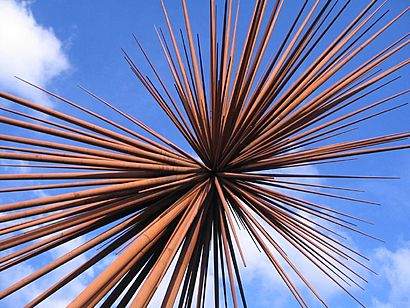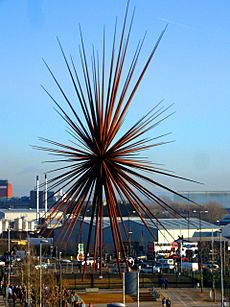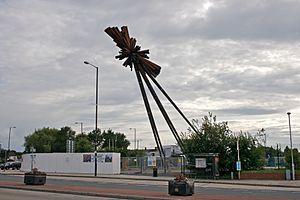B of the Bang facts for kids
Quick facts for kids B of the Bang |
|
|---|---|
 |
|
| Artist | Thomas Heatherwick |
| Year | 2005–2009 |
| Type | Metal sculpture |
| Dimensions | 56 metres (184 ft) tall |
| Location | Beswick, Manchester, England |
The B of the Bang was a very tall sculpture in Manchester, England. It stood right next to the City of Manchester Stadium at Sportcity. A famous designer named Thomas Heatherwick created it. Sadly, the sculpture had some problems and was taken apart in 2009.
This amazing sculpture was built to celebrate the 2002 Commonwealth Games. It was one of the tallest structures in Manchester. For a while, it was even the tallest sculpture in the whole UK! It was taller and leaned more than the famous Leaning Tower of Pisa. The sculpture got its unusual name from a quote by British sprinter Linford Christie. He once said he started his races not just at the "bang" of the starting pistol, but at 'The B of the Bang'.
The idea for the sculpture came about in 2003. Building it took longer than planned, so its official opening was delayed until January 12, 2005. Just six days before the big launch, a piece of the sculpture broke off. This was the first of several problems. A year later, legal action began, and the city received £1.7 million to cover damages.
In February 2009, Manchester City Council announced that the sculpture would be taken down. They said this was the "only practical choice." The council hoped to store it and maybe rebuild it later. However, when it was removed, the main parts of the sculpture were cut into pieces.
Contents
What Was B of the Bang?
The B of the Bang was originally 56 metres (184 ft) tall. It had 180 hollow steel columns, or "spikes," sticking out from its middle. The sculpture leaned at a 30-degree angle. It was held up by five strong steel legs, each 25 m (82 ft) long. These legs connected to the spikes 22 m (72 ft) above the ground. The whole sculpture weighed 165 tonnes. Its foundations were very deep, about 20 m (66 ft), and weighed over 1,000 tonnes!
The sculpture was made from a special material called weathering steel. This is the same type of steel used for the Angel of the North sculpture. This steel slowly forms a protective rust layer when it's outside. This layer stops the steel from rusting further. The spikes were designed to move a little in the wind. This helped them stand strong against winds over 100 mph (160 km/h). A time capsule was placed inside one of the spikes when it was built. It held children's poems and paintings. It was meant to be opened around the year 2300. We don't know where the time capsule is now that the sculpture is gone.
B of the Bang was located next to the City of Manchester Stadium in Beswick. It was at the corner of Alan Turing Way and Ashton New Road. As mentioned, its name came from Linford Christie's quote about starting races. Local people sometimes called the artwork KerPlunk. This was after a popular children's game from the 1970s.
Before another sculpture called Aspire was built in 2008, B of the Bang was Britain's tallest sculpture. It was twice as tall as the Angel of the North, which is 66 feet (20 m) tall. The sculpture was designed to look like an exploding firework. It was taller and leaned more than the Leaning Tower of Pisa. New East Manchester Limited asked for the sculpture to be built. It was to remember the 2002 Commonwealth Games. Local people and art experts chose the design in a competition in 2002.
Building the Giant Sculpture
The B of the Bang was built in Sheffield. Many companies worked together on it, including Thomas Heatherwick Studio. The project was approved in early 2003. The large central part of the sculpture arrived in Manchester on June 13, 2004. This was the biggest piece that could be moved by road from the factory. It even needed a police escort! This central part was lifted into place in August 2004. After that, the 180 spikes could be attached. At first, people thought it would be finished by July 2003. This early estimate led to the sculpture being nicknamed G of the Bang (meaning "Guess of the Bang").
The official opening ceremony happened on January 12, 2005. Linford Christie, the sprinter who inspired the name, was there.
The sculpture cost £1.42 million to design and build. This was twice the first guess. The first cost estimate had not included the money needed to put the sculpture together. The money came from different places. The European Regional Development Fund gave £700,000. The North West Development Agency gave £500,000. And Manchester City Council gave £120,000.
Problems and Legal Action
Just six days before the official opening, on January 6, 2005, the tip of one of the 2.1 m (6.9 ft) spikes broke off. It fell from the sculpture. After checking it, the opening event still went ahead.
Four months later, in May 2005, another spike came loose. Firefighters had to cut it off. The area around the sculpture was closed to the public. Some of the joints were re-welded. Special equipment was added to 170 spikes to stop them from moving too much.
Even with these changes, B of the Bang stayed fenced off. A local newspaper started a campaign called 'Get It Sorted'. In May 2006, nine spikes were taken off the sculpture. They were sent for testing to see what was causing the problems with the steel.
In October 2007, Manchester City Council announced they were taking legal action. They wanted the companies that made the sculpture to fix it. In November 2008, the council reached an agreement. The designers and builders agreed to pay the council £1.7 million. This money was for breaking their contract and for being careless.
Taking Down the Sculpture
In January 2009, the city council suggested that B of the Bang should be taken apart. They wanted to store it until they could find money to fix it safely. The report said the sculpture was important for Manchester. The council promised to work with the artist to find a long-term solution. One idea was to replace the steel spikes with lighter ones made from carbon fibre. But this would need a lot of testing.
In January 2009, Antony Gormley, who created the Angel of the North, spoke up for B of the Bang. He said, "It is a great tribute to Manchester that this ground-breaking work was commissioned. To allow it to disappear would be a loss not just of an inspirational artwork but also of the council's nerve."
Even with Gormley's plea, work to remove B of the Bang started in April 2009. More fences were put up around the site. A company began cutting off the spikes using special equipment.
The council had promised to store the main core and legs of the sculpture. But these parts were also cut into pieces during the removal. This made it unlikely that the famous sculpture would ever return.
Images for kids





